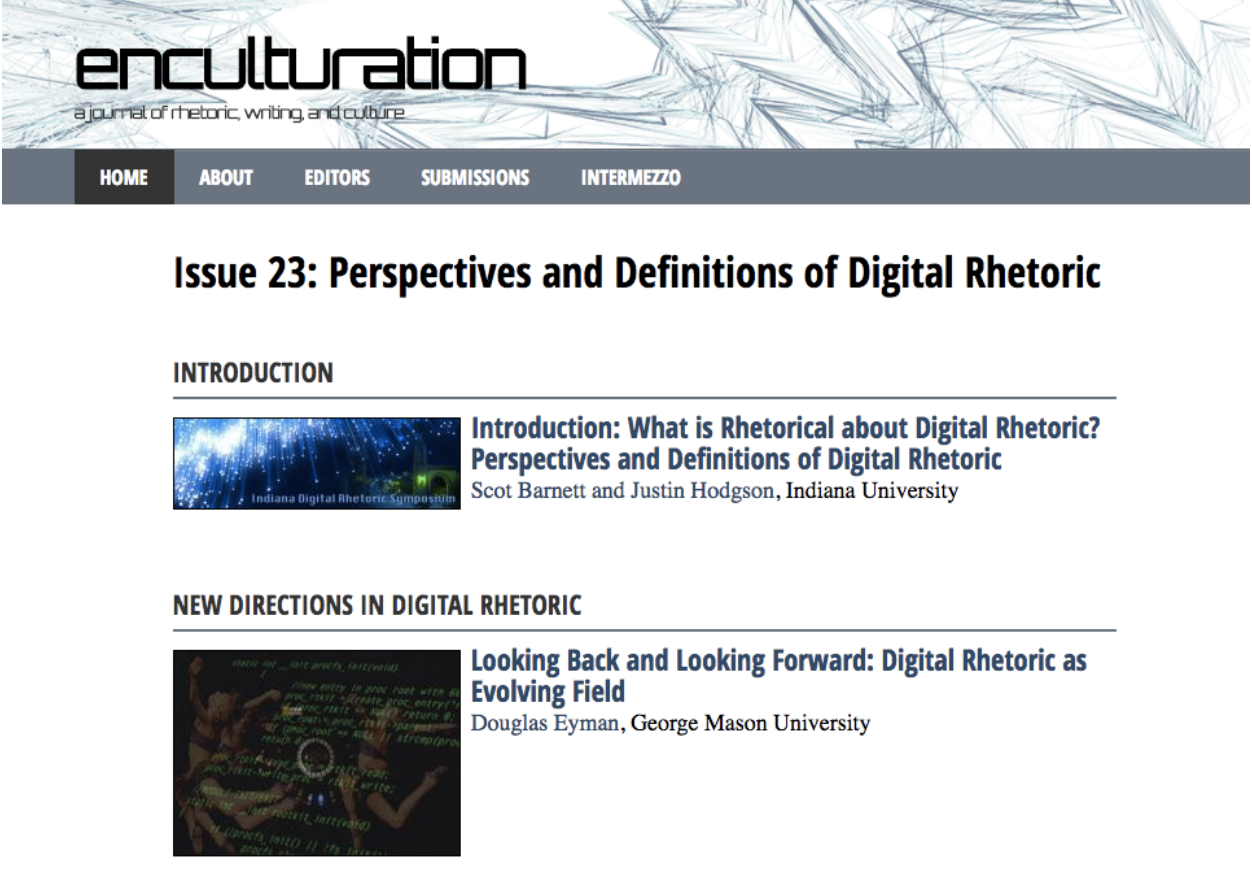Title: Introduction to Enculturation, Issue 23: Perspectives and Definitions of Digital Rhetoric
Author(s): Justin Hodgson and Scot Barnett
Publication: Enculturation
Publication date: November 22, 2016
Experience here/Website: http://enculturation.net/what-is-rhetorical-about-digital-rhetoric
Image/Screen Capture:

Although most of the DRC’s “Webtext of the Month” emphasize engaging and hypertextual composition innovations, the focus of this month’s webtext is an online, primarily text-based introduction to the recent issue of Enculturation. The introduction, written by Scot Barnett and Justin Hodgson, focuses on some general observations from the April 2015 Indiana Digital Rhetoric Symposium (IDRS), which brought together a number of rhetoric scholars to discuss what defines digital rhetoric. The outcome was less than solidified, as many scholars had vague or contradictory views of the definition.
(When you read this webtext, be sure to watch the video in the middle, which highlights, in a somewhat humorous manner, the challenges of defining.)
A clear and agreed-upon definition is one of the struggles we all face as scholars who identify with digital rhetoric: as Barnett and Hodgson ask, “what makes digital media rhetorical? Conversely, how are digital media, technologies, practices, and environments reshaping our understandings of rhetoric?”
These questions and concerns are familiar to us at the DRC; our very first Blog Carnival was on defining digital rhetoric. Additionally, Claire Lauer’s webtext in Kairos entitled “What’s in a Name”, which was reviewed in Blog Carnival 1, explores this very question on a broader scale.
One challenge that comes with defining the term—a challenge not as thoroughly addressed in the DRC Blog Carnival—is the various scholarly, disciplinary, and pedagogical contexts that digital rhetoric is used within. As Barnett and Hodgson write: “Much like understandings of rhetoric, what constitutes digital production, theory, and pedagogy shifts and contorts not just over time but across different contexts and environments as well.” Rather than looking at the inability to pin down a definition as a hinderance, Barnett and Hodgson frame the question optimistically, arguing that the lack of a rigid or stable definition of digital rhetoric opens up possibilities and new forms of rhetorical study.
Generally speaking, the field of digital rhetoric has been seeking and continues to seek clearer definitions of its core terms as a way to know what we do. And though one may leave the introduction with a less than complete idea of how to define digital rhetoric, the rest of the Enculturation issue explores the term through various theoretical perspectives and histories: for example, Douglas Eyman’s essay “Looking Back and Looking Forward” describes the digital rhetoric in relation to the history of Media Studies and Computers and Writing.
The quest to define digital rhetoric also brings up many questions for scholars and teachers in our discipline (as the publications in this issue suggest):
- What is the difference between new media and rhetoric, if any?
- How does digital humanities compare and contrast with concerns of digital rhetoric?
- What is the role of machines in relation to rhetorical concerns of authorship? (Can machines be authors? Can they be co-authors? Etc.)
- How do we define and articulate the history of digital rhetoric given the three decades that the term has existed?
- What are the methods by which we seek to understand digital rhetoric?
- And how may digital rhetoric fit into concerns of materiality?
For composition instructors who are introducing digital rhetoric in FYC courses, advanced writing courses, or courses focusing on writing in digital environments, this introduction and the other webtexts in the issue certainly serve as a jumping-off point for understanding the need to discuss what we mean by digital rhetoric, how confusing such a widely-used term can be, and how we may address complications surrounding such a term in our future scholarship.
